May 27th, 2013 ~ by admin
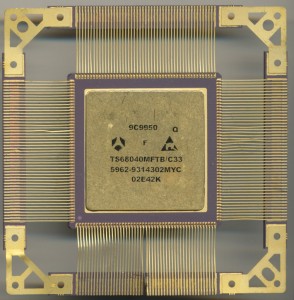
Thomson TS68040MFTB/C 33 5962-9314302MYC
Since its Memorial Day here in the United States, the CPU for the day needed to be something mil-spec. This is a very nice Thomson-CSF (part of STMicroelectronics) 68040 processor. The 68040 was released in 1990 by Motorola and was the first of the 68k line to include a full FPU on chip (as opposed to using the 68881/2).
This Thomson part was made in 1999. It is full military temp range (-55 -> 125C) with MIL-STD-883 Class B screening running at 33MHz. Its in a fairly rare (and available by special request only) ‘flat tie bar package’ This is similar to the more common ceramic quad flat pack (CQFP) but the leads are contained and supported by tie bars on the ends. These tie bars are physically attached to the board offering a very strong mechanical support for the processor in environments where high vibrations or higher then normal g-forces may be encountered. The life of a soldier is not an easy one, so electronics must be made to support them, and not fail.
May 25th, 2013 ~ by admin
Apple 1 computers, one of the first personal computers, were introduced in 1976. Now 37 years old they are setting records for auction sales. In September 2010 one fetched over $20,000 on eBay. A few months later one with the original box and papers cleared $200,000. And this week an auction house in Germany sold one for 516,000 Euros (around $670,000 depending on the exchange rate). Apparently a refurbished and now working model. this is one of the highest prices ever for a vintage computer.
Who knows, in 30 years the original iPhone 2G may set records for sales, but considering the number built, who knows how many will be around in 2040, or how many will have the original box.
May 23rd, 2013 ~ by admin
Jack Ganssle wrote an article on the continued demand for 4 and 8-bit microcontroller. Every year the ‘experts’ and sales people claim will be the end of the 8-bit microcontroller. Companies have strived to make upgrade paths to 32 bit. But the fact remains, basic microcontrollers, sold for pennies, are all that is needed for the majority of applications, applications that we use everyday without a single thought of the processor in it.
Ken Olson, head of Digital Equipment Corporation, said in 1977 (six years after the first commercially-successful microprocessor was introduced) “There is no reason anyone would want a computer in their home.”
Count the processors in your home and ponder that statement. Unless you live in a cave you do not have enough fingers and toes to count all the computers in your home. Its a good read, check it out.
May 21st, 2013 ~ by admin
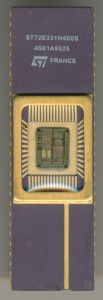
8-bit 8MHz w/ ADC and 16K EPROM
One of the most well known microcontroller families is the Intel MCS-51. It was introduced in 1980 and is still being made in many many forms. It, however, is not the only popular 8-bit microcontroller. Motorola made many microcontroller versions of the famous 6800 CPU. Namely the MC6804 and the still in production 68HC05 series.
ST, which was formed by the merger of SGS of Italy, and Thomson of France, also makes a wide range of 8-bit microcontrollers which are very popular and widely used. The ST7 microcontroller is a 8-bit Von Neumann architecture (shared address/data bus) MCU. It is a serial accumulator design (so all operations occur in the accumulator, rather than in a wide set of registers like the 8051). The ST7 was introduced in the early 1990’s as an upgrade to the ST6 Family of microcontrollers. The ST7 added more high level programming support, and better interrupt handling. The ST7 provides higher performance then many competing architectures and in various performance tests such as IRQ handling, returns, instruction execution times etc, it even beats the venerable 80C51.
Both the ST6 and ST7 families are based on the Motorola MS680x microcontroller family. The ST6 closely resembles the 6804 and the ST7 is upwards code compatible with the MC68HC05 (assembly level translators exist to port the raw code). The ST7 has 63 instructions and the 6805 has 62 (depending on version). It is not an uncommon practice for one MCU to be based off, or even compatible with another. It provides more familiarity for programmers and design engineers. What really sets a MCU apart is the peripherals that surround the core, and its operating parameters. The ST6 and ST7 are both highly respected for their ESD protection and high noise immunity. These features were both carried over into the ST8M family that was introduced in 2008 to replace the aging ST7. The ST7 can be found in many applications such as automotive appliance control, motor control, and other embedded systems that most people forget are run by a processor.
May 16th, 2013 ~ by admin
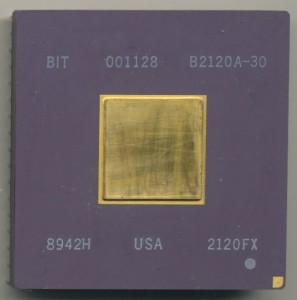
B2120A Floating Point ALU 1989 33MHz
Bipolar Integrated Technology Inc. (BIT) was founded in 1983 in Beaverton Oregon by former Floating Point Systems, Intel, and Tektronix engineers. Their goal was to develop fast floating point processors based on a bipolar process (rather then the more common NMOS and CMOS of the time. The bipolar process is used to make TTL, and ECL type products, and had been used in several previous processors, including the AMD 2901 and the SMS300 (Signetics 8X300).
The B2120 was part of a complete floating point chip set that was released in 1987. the B2120 handled all the ALU functions, while the B2110 was the multiplier. It was designed by Bob Elkind who was one of the original employees of BIT and oversaw the development, layout, and packaging of most of their early products. The B2120 was a TTL compatible device while the B3120 and B3110 made using ECL 10KH instead. Both were made using Bipolar’s proprietary P111 1.2 micron process. The B2120A-30 had a typical cycle time of 30ns, giving it an effective clock rate of 33MHz.
In 1990 BIT introduced the B2130 (TTL) B3130 (ECL 10KH) and B4130 (ECL 100k) which were 100MHz single chip versions of the 2110/2120
BIT would later make a SPARC chipset called the B5000 (which at 80MHz was the fastest processor of its time) and a follow on version called the B6000. Both were made using ECL. Reliability problems and the eventual catchin up of CMOS in speed led to their demise, and in 1996 BIT was purchased by PMC-Sierra (who ended up consolidating a lot of 80’s and 90’s companies).
May 6th, 2013 ~ by admin
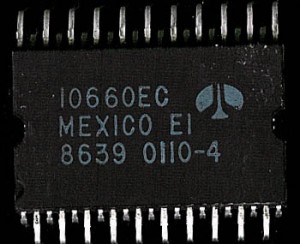
Rockwell 10660EC PPS-4 – 1986
The Intel 4004 processor gets much attention for being the ‘first’ processor, however, there were others. The Rockwell PPS-4 was introduced in 1972, making it one of only 4 processors of the time (IMP-16 from National Semiconductor, Intel 8008 and Intel 4004 being the others.
The original PPS-4 came in a 42 pin Quad Inline package, compared to the 4004s somewhat limiting 16 pins. A complete system could be built using 3 chips, a 10660 (later the 12660) PPS-4 processor, a ROM, and a clock generator (10706). The PPS-4 was manufactured on a metal gate process (vs the silicon gate process of the 4004). It required a single -17VDC power supply and ran at 256KHz.
In 1975 Rockwell introduced the PPS-4/2 (aka the 11660). The ‘/2’ denoting the 2 chip version of the PPS-4. The clock generator was now moved onto the processor itself, and a memory/IO chip (part # A17xx) that provided 2048×8 bits of ROM 128×4 bits of RAM and 16 1 bit I/O ports. Clock speed was 200KHz, slightly less than that of the 3 chip PPS-4.
Rockwell was not done with the PPS-4. In 1976 they released the PPS-4/1, which was a single chip microcomputer version, integrating ROM onto the processor so that a system could be built with one chip. The standard version (the MM76) had 64×8 bits of ROM and 48×4 bits of RAM. Clock frequency could range from 40KHz to a blistering 120KHz. The PPS-4/1 was compatible with peripherals of the newly released PPS-8 as well. Additional versions were made including:
MM75: Reduced I/O 28 pin version
MM76E: Extended memory 1024x8bits of ROM
MM76C: Included a high speed counter and expanded I/O in a 52 pin package (140KHz max speed)
MM76D: Includes a ADC 52 pin package
MM76L/EL: Low voltage/low power version (-11 – -6.4 volts vs -15 of the standard parts)
MM77: 1344×8 ROM 96×4 RAM
MM78: 2048×8 bit ROM 128×4 RAM
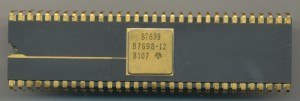
Rockwell B7699 PPS4/1 Low power External ROM Development device – 1981
A7699: Development version without on board ROM – requires external clocking
A7698: Development version without on board ROM – Can use internal clock
B769x: Development version for the MM76L/EL Low power versions
Unlike the Intel MCS-4/40 the Rockwell PPS-4 and its derivatives continued to be made and used well into the late 1980’s






